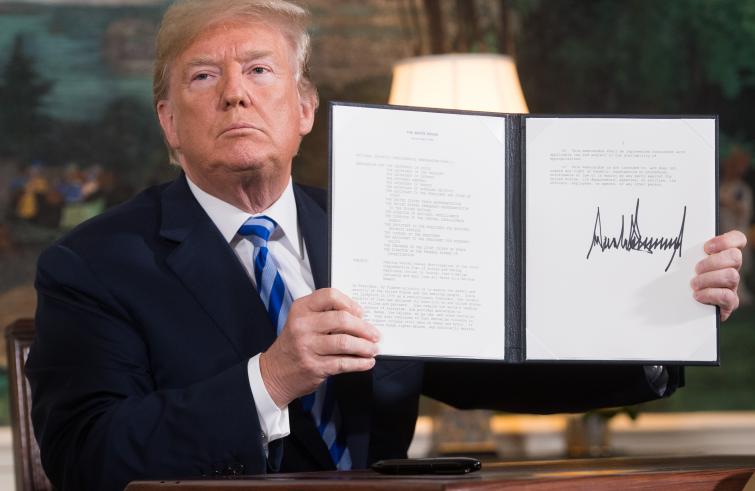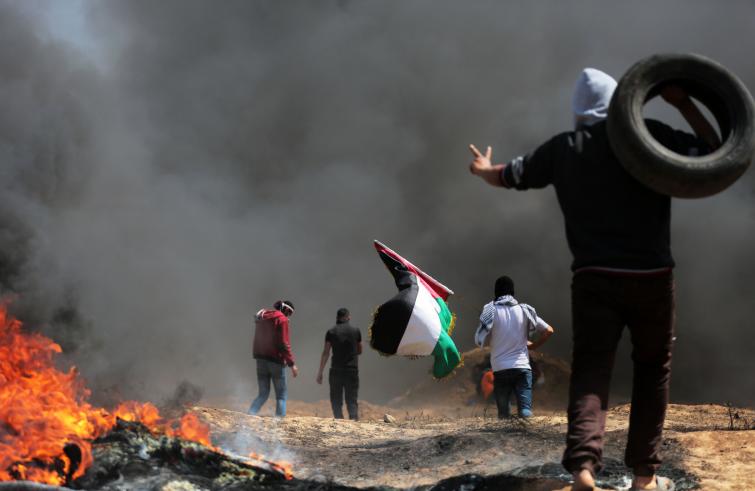Holy Land
Hours of tension and concern in Jerusalem and Gaza. The Holy City is preparing for the transfer of the US Embassy from Tel Aviv, planned for May 14th. Rising fears in Gaza in view of the final “March of return” organized by Hamas for May 15, “Nakba Day.” Two more protests are due to take place today and on Monday, May 14th. Ahead of these events, SIR has collected personal accounts describing the situation in Jerusalem and Gaza.

From Jerusalem to Gaza and back: the hours separating the transfer of the US embassy from Tel Aviv to the Holy City, scheduled for May 14, marking the 70th anniversary of the Independence of Israel, and the last major mass protest in Gaza, set for May 15 in the framework of the “March of Return” with which the Islamist movements claims the “right to return” of the descendent of Palestinians who fled or were expelled from their homes in 1948, in the territories now controlled by Israel, will be consumed along this short stretch of road. The exodus that the Palestinians named “Nakba” (“catastrophe”, in Arabic) coincides with the birth of the State of Israel.
 On December 6 2017 US President Donald Trump formalized Jerusalem’s status as capital of Israel, superseding his predecessors’ decision to act with caution by renewing the “Presidential Waiver”, allowing to postpone by six months the Jerusalem Embassy Act of 1995 that recognized Jerusalem as the capital of Israel. The decision, for the time being, has a purely symbolical value, since only Ambassador David Friedman and a small group of officers will move to the US consular services site of Arnona, half-way from Jerusalem and Bethlehem.
On December 6 2017 US President Donald Trump formalized Jerusalem’s status as capital of Israel, superseding his predecessors’ decision to act with caution by renewing the “Presidential Waiver”, allowing to postpone by six months the Jerusalem Embassy Act of 1995 that recognized Jerusalem as the capital of Israel. The decision, for the time being, has a purely symbolical value, since only Ambassador David Friedman and a small group of officers will move to the US consular services site of Arnona, half-way from Jerusalem and Bethlehem.
Jerusalem. The protests and strikes called by the Palestinians and the clashes with the Israeli army that had followed the announcement, are but a distant memory today. “At least on the surface – Fr. Pietro Felet, Secretary General of the Assembly of the Catholic Ordinaries of the Holy Land– told SIR.
the atmosphere in Jerusalem is one of utter calmness
And as often happens here, nobody can predict what will happen next. We shall see how things develop. However, the transfer takes place at a time of tension in the north of Israel (Lebanon and Syria, Ed.’s note) We hope there will be no more violence. For now, nobody speaks about the transfer of the US embassy. Even our faithful never mention the issue. But this doesn’t mean they are not worried, quite the contrary in fact.” “Here in Jerusalem we see conflicting dispositions – Msgr. Giacinto-Boulos Marcuzzo, Patriarchal vicar for Jerusalem and Palestine since 2017 – told SIR.
our Jewish brothers are elated while our Muslims brothers, along with the Christian community, who are Palestinian Arabs, are deeply concerned because what is happening, the transfer of the US embassy, the clashes in the Golan Heights and the escalating tensions between Israel and Iran, coupled by the protests in Gaza, only serve to alienate peace from this region. Peace-building requires an approach that is not based on violence.”
 “Today is Friday– added Msgr. Marcuzzo – and like every Friday there is widespread fear about possible incidents. Many people prefer not to go out of their homes.” In this situation the Christian Churches of Jerusalem, pointed out the patriarchal vicar, “reiterate their appeal released on the occasion of the ecumenical gathering for peace that will take place next July 7 in Bari, on the initiative of Pope Francis, to pray on the tragic situation of the Middle East.
“Today is Friday– added Msgr. Marcuzzo – and like every Friday there is widespread fear about possible incidents. Many people prefer not to go out of their homes.” In this situation the Christian Churches of Jerusalem, pointed out the patriarchal vicar, “reiterate their appeal released on the occasion of the ecumenical gathering for peace that will take place next July 7 in Bari, on the initiative of Pope Francis, to pray on the tragic situation of the Middle East.
We call upon the political leaders of the interested Countries to work for peace.
 Don’t follow ideologies or party interests: have at heart the good of all peoples, no one excluded.” Pilgrims are beacons of light amidst Jerusalem’s many shadows. Pilgrimages are on the rise, pilgrims are returning in high numbers – said Msgr. Marcuzzo –especially from Eastern Europe, notably Russia and Ukraine, and from Asia, from countries like Vietnam, China, Malaysia, Philippines, Indonesia, Korea, Japan. There are no grounds for concern for pilgrims in the Holy Land, where they are deemed ‘untouchable’ by all.
Don’t follow ideologies or party interests: have at heart the good of all peoples, no one excluded.” Pilgrims are beacons of light amidst Jerusalem’s many shadows. Pilgrimages are on the rise, pilgrims are returning in high numbers – said Msgr. Marcuzzo –especially from Eastern Europe, notably Russia and Ukraine, and from Asia, from countries like Vietnam, China, Malaysia, Philippines, Indonesia, Korea, Japan. There are no grounds for concern for pilgrims in the Holy Land, where they are deemed ‘untouchable’ by all.
Today more than ever peace in Jerusalem proceeds with the pilgrims’ pace. You can serenely come to the Holy Land.”
Gaza Strip. While in Jerusalem the atmosphere is one of calmness, the same cannot be said for the Gaza Strip, marked by growing “fears” ahead of three demonstrations held at a close distance from each other. The first one today, May 11, calling for the right to return of Palestinian refugees, the second on Monday 14 to protest against the transfer of the US Embassy to the Holy City, and on Tuesday 15, a major mass protest on Nakba Day will close the March of Return begun on March 30, that left dozens dead among Palestinian protestors and thousands wounded. Speaking to SIR, the Latin Patriarch of Gaza, Father Mario Da Silva underlined “the climate of tension and fear.”
“There is widespread fear over what could happen. It has been this way for a long time, unfortunately. Tensions are escalating”,
remarked the Brazilian prelate at the lead of a small Catholic community consisting in less than 100 faithful who gather in the “Holy Family” parish church, located in the eastern neighbourhood of Al-Zeitoun, in Gaza.
 Fr. Da Silvia made the umpteenth appeal for the Gaza Strip: “Pray for peace in this land. No more wars! No more violence!” Other local sources, contacted by SIR and who requested anonymity, described the “worsening social and economic conditions of the population” (more than 40% of Gaza’s population are unemployed and 80% depend on international aid, Ed.’s note.) that is bound to aggravate people’s anger, undermining families’ living conditions, worsened by the Israeli blockade.
Fr. Da Silvia made the umpteenth appeal for the Gaza Strip: “Pray for peace in this land. No more wars! No more violence!” Other local sources, contacted by SIR and who requested anonymity, described the “worsening social and economic conditions of the population” (more than 40% of Gaza’s population are unemployed and 80% depend on international aid, Ed.’s note.) that is bound to aggravate people’s anger, undermining families’ living conditions, worsened by the Israeli blockade.
In this situation there is no other option but to wait and see. There will be days of tension that we hope will not cause more bloodshed and death. Gaza needs help and peace. It does not need another war.”